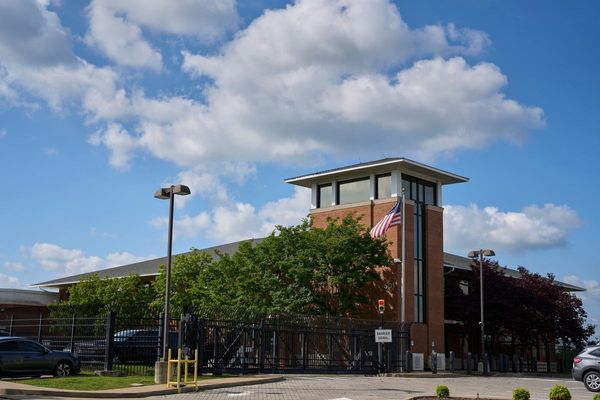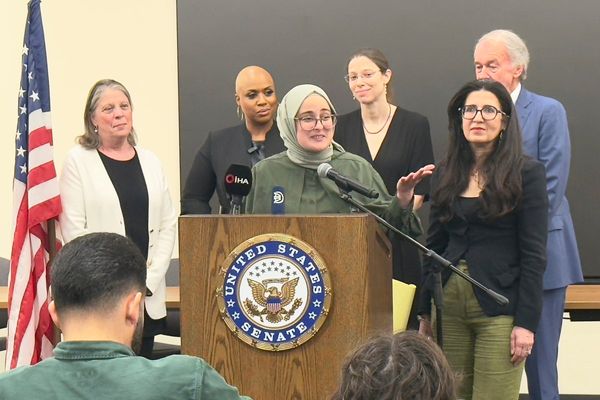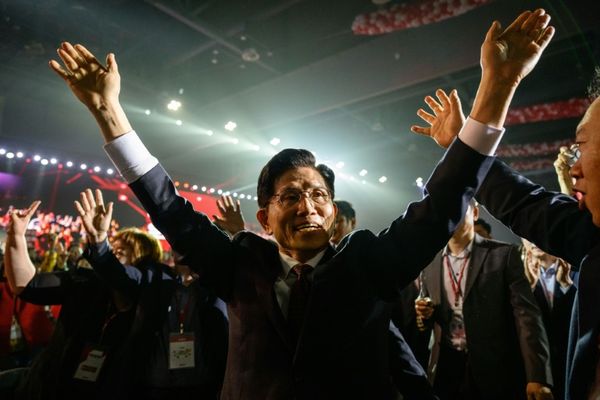
When I was a teenager in the early 2000s, my parents both died. Like many American children, I had been steeped in stories about orphans for years, but the books I had read and movies I had watched (Jane Eyre, Annie) failed to mirror my experience of parental loss. They also contributed to my mistaken understanding of orphanhood and the makeup of our child-welfare system—misconceptions that many Americans hold today.
For one, I believed that orphanages were still common in the United States—the reality is that most closed in the years following World War II. And I had only the vaguest sense of what foster care was, even though that’s where my brother and I would have likely ended up were it not for certain facts of our situation: We were middle-class, white, and had extended family ready to care for us. It wasn’t until I began researching my book on American orphanhood that I came to fully appreciate how much class and race have always determined who gets to have a family.
The two primary ways that the American child-welfare system has functioned over the past couple of centuries—through orphanages and foster care—are the subjects of two new books: Ghosts of the Orphanage: A Story of Mysterious Deaths, a Conspiracy of Silence, and a Search for Justice, by Christine Kenneally, and We Were Once a Family: A Story of Love, Death, and Child Removal in America, by Roxanna Asgarian. These books make clear how both systems have largely disregarded the problem that most families within them face: not necessarily the death of parents, but poverty. This was true even in the mid-to-late 19th century, when the number of American orphanages grew rapidly because of the confluence of mass immigration, a series of epidemics, the Civil War, and the rise of industrialism, which created an unreliable labor market and, in turn, poverty on a new scale. During this period, few children in orphanages—most of which were Catholic or Protestant and housed only white children—were orphans at all. Most had one or two living parents who were simply too poor to take care of them.
The child-welfare system underwent a massive transformation in the mid-20th century when it mostly moved away from private institutions and supplanted them with publicly funded in-home foster care. Now the top reason Child Protective Services removes children from their biological parents and places them in foster care is neglect, a loose category—cited in about two-thirds of cases—that varies by state, but that typically is defined as a failure to meet a child’s basic needs or prevent them from experiencing serious harm. Of course, poverty can make fulfilling those needs—adequate and nutritious food, clothing, and shelter—more difficult. There are also clear racial disparities in the system: Out of the approximately 400,000 children who are in foster care each year, Black and Indigenous children make up a disproportionate share.
Though there are certainly individuals who are committed to their work and have helped kids in dangerous situations, the child-welfare system at large has too often failed to keep safe the children it is supposed to care for. Many children are removed from their families only to experience trauma, neglect, and abuse. Though Kenneally’s and Asgarian’s books focus on specific stories, they help illuminate the repercussions of America’s broken child-welfare system and the ways it has failed to best serve kids and families—showing how urgently the country needs to reimagine it.
In Ghosts of the Orphanage, Christine Kenneally builds on her bombshell 2018 feature for BuzzFeed News, which exposed how Catholic nuns and priests abused children at St. Joseph’s Orphanage in Burlington, Vermont, for most of the 20th century. Though the experiences of St. Joseph’s survivors form the book’s backbone, Kenneally zooms out to develop a broader condemnation of Catholic orphanages across the U.S., and even worldwide. The result is a damning reckoning with a tragedy she calls a “mass catastrophe.”
As Kenneally writes, “the cloistered and cruel world of the orphanage may seem utterly fantastical, but the events that took place there belong very much to reality.” She notes that it was common for nuns to force children to eat their own vomit and to humiliate them by draping damp sheets around them after they wet the bed. Survivors describe nuns and priests hitting them with paddles, locking them in attics, and pulling them out of bed to sexually abuse them. Harrowingly, Kenneally even recounts allegations of at least half a dozen deaths at St. Joseph’s—some of which seemed to be preventable accidents, and some which were alleged murders. A task force composed of state and local authorities, convened after the publication of Kenneally’s BuzzFeed article, ultimately could not corroborate the murder charges; the Sisters of Providence, who ran the orphanage, did not furnish documents requested by the investigators.
Although Kenneally’s focus is on finding out what happened to children at orphanages rather than exploring how they ended up there in the first place, the picture she paints of St. Joseph’s fits neatly into the larger history of orphanhood in America. First, she confirms that in many cases poverty, not parentlessness, forced these children into the institution. Many children were left at St. Joseph’s by their desperate parents or delivered there by authorities who had found their homes “unacceptable.” “Most were extremely poor,” Kenneally writes. “One girl drank milk for the first time at St. Joseph’s and thought it was the most delicious thing she had ever tasted.” St. Joseph’s also represents the outsize role the Catholic Church has played in shaping American child welfare. The orphanage opened in 1854 as part of a nationwide surge that reflected the Church’s efforts to help poor Catholic immigrants, protecting them from competing Protestant organizations that might try to convert and Americanize their children. Its doors closed only in 1974, well after the establishment of the foster-care system.
The eventual fall of orphanages after World War II came as the result of a campaign that began in the Progressive era, when activists decried them as regimented, overcrowded places that provided inadequate care. In 1909, a meeting of child-welfare professionals and advocates at the White House reached the consensus that home life was best for children. But it would be decades before that ideal started to materialize. As Kenneally notes, the number of American orphanages actually peaked in the 1930s, when as many as 1,600 were in operation. Some hung on far into the post–World War II era, and continued to rely on the labor of untrained nuns. Not until the 1990s did former St. Joseph’s residents—by then in their 40s and older—begin to collectively reckon with what had happened to them, pursuing lawsuits against the diocese, Vermont Catholic Charities, and the Sisters of Providence.
Kenneally’s book makes a strong case for the importance of studying this history, arguing that America’s 20th-century orphanages are the “immediate ancestor of its modern foster-care system”—an institution we can’t understand while remaining “blind to the stark realities of the system that preceded it.” She argues that the general public’s murky knowledge of orphanages ensured that what was perpetrated within them stayed hidden. A similar kind of ignorance surrounding foster care might well be obscuring many of the problems in that system.
We Were Once a Family uncovers the failures of modern foster care through the story of the notorious Hart-family murder-suicides. In March 2018, a white lesbian couple drove their SUV off a cliff in California, killing themselves and their six adopted Black children. Jennifer and Sarah Hart had adopted these children from foster care, welcoming them into what had seemed like a happy family whose social-media presence gave the impression of a loving environment. In reality, as Asgarian reveals, the pair mistreated and neglected the children for years, evading CPS in several states.
The media focused mostly on Jennifer and Sarah’s motives and backgrounds, overlooking what Asgarian calls “major questions about the child welfare system’s role in the deaths.” We Were Once a Family fills in this crucial gap by tracing how two Texas sibling groups—first Markis, Hannah, and Abigail, and then Devonte, Jeremiah, and Ciera—came to be removed from their families and adopted by the Harts, even though the children had family members who were willing and able to take care of them.
Asgarian forged remarkable connections with the birth families, both of whom were largely ignored in the aftermath of the murders. She writes that she was “struck by the lack of dignity in the way these families were treated, as they repeatedly grieved the loss of their children—first to the state, and then to their murderers.” By meticulously showing how social workers, legal officials, and other authorities repeatedly failed the families, We Were Once a Family powerfully uses this one story—though clearly an extreme case—to expose how what happened to these children is indicative of the classism and racism still baked into the institution.
When the United States began looking beyond orphanages, a new profession—social work—emerged. Within a few decades, when state-sponsored CPS was established, caseworkers would investigate families who had been accused of maltreatment. If caseworkers deemed that the children were being harmed, they would place them in foster care until birth parents could prove to family-court judges that they were worthy of getting their children back—or not, triggering the termination of parental rights and making the children adoptable.
This practice is in many ways more logical than the orphanage system, and there are undoubtedly children who have been removed from unsafe homes. But as Asgarian demonstrates, it is also rife with pitfalls. After all, it was CPS caseworkers and judges who took these six children from their birth families and placed them with the women who would eventually kill them. In the early 2000s, when both Texas families’ CPS cases were active, the state comptroller found that caseworkers were saddled with up to 35 children at a time, “more than double the recommended amount,” meaning that some children weren’t visited by a caseworker for months. The family-court situation was also problematic. Asgarian spoke with a number of people who worked with the district-court judge responsible for Devonte, Jeremiah, and Ciera’s case, finding that they all agreed on one thing: He “prized quick resolutions to cases above all else.”
As Asgarian reconstructs how the children came to be adopted by the Harts, she methodically lays out how federal policies such as the Adoption and Safe Families Act—which accelerated the timeline for termination of parental rights—have disproportionately affected Black children, whose parents are more than twice as likely to lose parental rights as white parents. While the birth families were subjected to intense scrutiny by caseworkers and judges, the Harts received “glowing reports” and had their adoption of Devonte, Jeremiah, and Ciera fast-tracked—even though the children’s aunt was simultaneously trying to adopt them, and even though one of Hannah’s teachers had already called CPS out of concern for her safety. Asgarian notes that “many people, both inside and outside the child welfare system, held a common assumption: that these six Black children must be better off with the white women who adopted them” than with their birth families.
As We Were Once a Family attests, although the country has evolved away from the nightmarish sectarian institutions that haunt Ghosts of the Orphanage, the progress is far from unmitigated. Asgarian explains that most CPS cases deal with families who are “already marginalized” by factors including race, class, and disability. Our country’s “punitive approach” to these families means that often, the root cause of families’ struggles goes unaddressed.
Stories like Kenneally’s and Asgarian’s help show that the government hasn’t provided vulnerable families with the kind of material assistance they need. During the heyday of orphanages, the state ceded this responsibility to private charities; the price paid was, in many instances, the terrible treatment of children. Now families are hurt when they get caught in the dysfunctional web of the foster-care system, and many children are still experiencing mistreatment in government care. Both Kenneally and Asgarian argue that our child-welfare system has never served the best interests of children and families. Fixing it would require a “radical reimagining of what support for parents looks like,” as Asgarian writes. But it also demands something she deems even more difficult for many people to let go of: “the urge to judge and blame parents and … punish them for their failures.”







